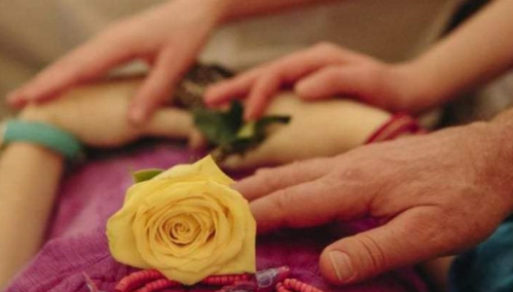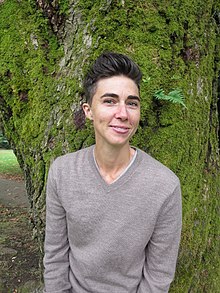Today SevenPonds presents the second in a two part interview with Katrina Spade, the founder and CEO of Recompose. Katrina has been an entrepreneur and designer since 2002. She has over 15 years of experience in project management, finance and architecture, with a focus on human-centered, ecological solutions. While earning her Masters of Architecture, Katrina invented a system to transform the dead into soil, which is now patent-pending. In 2014, she founded the 501c3 Urban Death Project to bring attention to the problem of a toxic, disempowering funeral industry. In 2017, she founded Recompose, a Public Benefit Corporation.
Katrina has a BA in Anthropology from Haverford College and a Masters of Architecture from the University of Massachusetts, Amherst. She has been featured in the Guardian, NPR, Wired, Fast Company, and the NYTimes. She is an Echoing Green Fellow.
Editor’s Note: This interview has been edited for length and readability.

Credit: by Mike Bellame
Matt Driscoll: Hi Katrina. Thanks for speaking with us today. Are the methods like the ones being used by Recompose becoming more of a common practice?
Katrina Spade: Green burial is a method of burial that takes us back to the way we used to do things, and it’s a movement that’s happening all over the United States and beyond.
There are various organizations doing similar work to Recompose. For example, I know there’s another organization that creates urns that you can grow a tree out of. There are plenty of folks working on committing us more fully to the natural cycle.
I think of all those projects and organizations as essentially being allied together.
Matt: What’s the most common response you receive to the idea of recomposition?
Katrina: A lot of people have a distaste for the options that are currently available.
There’s a feeling that when someone dies, we don’t have control at all. Even when the funeral director is competent and caring, it still feels like something you don’t have a lot of control over. People are looking for another option that’s empowering.
We all have the capacity to care for someone when they die, but very few of us know that we have that capacity.
Matt: The process seems to be equal parts spiritual and practical, as opposed to current funerary practices, which are largely ceremonial. Was that part of the impetus for this project?
Katrina: Part of what I think is beautiful about this process, and I’m not sure everyone agrees with this, is that you can be useful one last time after you die. There’s something truly beautiful in giving back one last time, as opposed to being a drain on resources one last time.
Matt: Is there still some sort of ceremony associated with recomposition, or is that entirely up to the client?
Katrina: We want to create an opportunity for families to help us care for their loved one. That’s something we used to do all the time and there’s a lot of value emotionally in doing so. It’s hard for families these days to get that opportunity.
We encourage a ceremony that you might look at as a wake — a gathering of close friends and family, some of whom would actually wash and shroud the body. The rest would gather and help to do the work of creating the bedding material, laying the body on it and then turning the body into the vessel.
All of that we think of as the work of loving someone after they’ve died, and that is something really beautiful to be able to take part in.

Credit: katelynlagrega.com
Matt: Can you tell us anything interesting you’ve learned since you started this project?
Katrina: Mostly I’ve been surprised with the many different types of people who find this option moving. You don’t have to be your typical environmentalist to be interested in this.
Not everyone wants to take advantage of it, but most people get why it’s so important to have another option.
Matt: What’s the biggest challenge you faced since working on this project?
Katrina: Time is our biggest challenge. We have so much we want to get done. If all goes according to plan, we can open the doors on Recompose Seattle in the next two years. But there are so many things that have to fall into place in order for that to happen.
Right now we’re working hard to create policy here in Washington state to allow this project to be available to the general public. We’ve proven that it’s a safe process and we’re bringing a bill to the Washington State Legislature in January.
Our goal is to open the first recompose facility, Recompose Seattle, here in Washington state. It will provide people with the option of having a loved one transformed into soil they can use to plant a tree or whatever they like and really have the space and time they need to process.
Finding the resources to make this happen can also sometimes be a big challenge. To try and raise money, we need to find the people who get our vision.
Matt: How much would a process like this cost as opposed to a typical funeral?

Credit: Katrina Spade via Wikipedia
Katrina: We’re still working on cost.
A conventional burial can cost anywhere from $8,000 up to $35,000, depending on the location, the casket and other factors like that. Cremation can be anywhere from $700 up to something like $6,000. We’re never going to be able to be as cheap as the cheapest cremation, but we’ll be somewhere in the range of the cost of cremation or the cost of a burial.
We want to pay people well at Recompose Seattle and we want to give people the time that they need to make the process as comfortable as possible
Matt: Thanks, Katrina. I’m sure our readers will look forward to hearing more about Recompose in the future.
This concludes part two of our interview with Katrina Spade, CEO of Recompose. If you missed part one, please catch up here.

 What Is Recompose?
What Is Recompose?


 “Help Me, Helen”
“Help Me, Helen”
 Recovering Cremation Remains After the Los Angeles Fires
Recovering Cremation Remains After the Los Angeles Fires
 “As Tears Go By” by Marianne Faithfull
“As Tears Go By” by Marianne Faithfull














